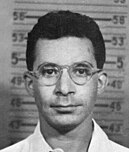Portal:Nuclear technology
The Nuclear Technology Portal
Introduction

- Nuclear technology is technology that involves the nuclear reactions of atomic nuclei. Among the notable nuclear technologies are nuclear reactors, nuclear medicine and nuclear weapons. It is also used, among other things, in smoke detectors and gun sights. (Full article...)
- Nuclear power is the use of nuclear reactions to produce electricity. Nuclear power can be obtained from nuclear fission, nuclear decay and nuclear fusion reactions. Presently, the vast majority of electricity from nuclear power is produced by nuclear fission of uranium and plutonium in nuclear power plants. Nuclear decay processes are used in niche applications such as radioisotope thermoelectric generators in some space probes such as Voyager 2. Generating electricity from fusion power remains the focus of international research. (Full article...)
- A nuclear weapon is an explosive device that derives its destructive force from nuclear reactions, either fission (fission bomb) or a combination of fission and fusion reactions (thermonuclear bomb), producing a nuclear explosion. Both bomb types release large quantities of energy from relatively small amounts of matter. (Full article...)
General images -
Selected article -
The development effort initially focused on a gun-type fission weapon using plutonium called Thin Man. In April 1944, the Los Alamos Laboratory determined that the rate of spontaneous fission in plutonium bred in a nuclear reactor was too great due to the presence of plutonium-240 and would cause a predetonation, a nuclear chain reaction before the core was fully assembled. Oppenheimer then reorganized the laboratory and orchestrated an all-out and ultimately successful effort on an alternative design proposed by John von Neumann, an implosion-type nuclear weapon, which was called Fat Man. A variant of the gun-type design known as Little Boy was developed using uranium-235.
Chemists at the Los Alamos Laboratory developed methods of purifying uranium and plutonium, the latter a metal that only existed in microscopic quantities when Project Y began. Its metallurgists found that plutonium had unexpected properties, but were nonetheless able to cast it into metal spheres. The laboratory built the Water Boiler, an aqueous homogeneous reactor that was the third reactor in the world to become operational. It also researched the Super, a hydrogen bomb that would use a fission bomb to ignite a nuclear fusion reaction in deuterium and tritium.
The Fat Man design was tested in the Trinity nuclear test in July 1945. Project Y personnel formed pit crews and assembly teams for the atomic bombings of Hiroshima and Nagasaki and participated in the bombing as weaponeers and observers. After the war ended, the laboratory supported the Operation Crossroads nuclear tests at Bikini Atoll. A new Z Division was created to control testing, stockpiling and bomb assembly activities, which were concentrated at Sandia Base. The Los Alamos Laboratory became Los Alamos Scientific Laboratory in 1947. (Full article...)
Selected picture -

Did you know?
- ... that after journalist Adele Ferguson's criticism of the U.S. Navy's sex discrimination attracted nationwide attention, she was offered a personal tour of a nuclear submarine?
- ... that Project Ketch proposed the detonation of a 24-kiloton nuclear device in Pennsylvania to create a natural-gas storage reservoir?
- ... that under college president Arthur Bronwell in 1959, Worcester Polytechnic Institute built one of the first nuclear research reactors at an American university?
- ... that coral cores from Flinders Reef capture environmental changes caused by the use of nuclear weapons?
- ... that according to witnesses, the plutonium charge in the bomb used in the nuclear weapons test Gerboise Verte was transported in an economy car?
- ... that T. K. Jones thought that a nuclear war was survivable if "there are enough shovels to go around"?
Related WikiProjects
Things you can do
| Parts of this portal (those related to section) need to be updated. Please help update this portal to reflect recent events or newly available information. Relevant discussion may be found on the talk page. (September 2021) |
Selected biography -
In 1942, Slotin was invited to participate in the Manhattan Project, and subsequently performed experiments with uranium and plutonium cores to determine their critical mass values. After World War II he continued his research at Los Alamos National Laboratory in New Mexico. On 21 May 1946, he accidentally began a fission reaction which released a burst of hard radiation. He was rushed to the hospital and died nine days later on 30 May. Slotin had become the victim of the second criticality accident in history following Harry Daghlian, who had been fatally exposed to radiation by the same plutonium "demon core" that killed Slotin.
Slotin was hailed as a hero by the United States government for reacting quickly enough to prevent the deaths of his colleagues. However, some physicists argue that Slotin's behavior preceding the accident was reckless and that his death was preventable. The accident and its aftermath have been dramatized in several fictional and non-fiction accounts. (Full article...)
Nuclear technology news
- 14 May 2024 –
- Russia places its nuclear capable submarine-launched Bulava intercontinental ballistic missile into service. (Reuters)
- 9 May 2024 – Joint Comprehensive Plan of Action, Iran–Israel relations
- Iran warns that it will build a nuclear weapon if Israel continues to target its nuclear facilities. (Al Jazeera)
- 25 April 2024 – Russia–NATO relations
- Russian Deputy Foreign Minister Sergei Ryabkov warns that Russia will make NATO nuclear weapons in Poland one of its primary targets if they are deployed there. (The Jerusalem Post)
Related portals
Related topics
Subcategories
Associated Wikimedia
The following Wikimedia Foundation sister projects provide more on this subject:
-
Commons
Free media repository -
Wikibooks
Free textbooks and manuals -
Wikidata
Free knowledge base -
Wikinews
Free-content news -
Wikiquote
Collection of quotations -
Wikisource
Free-content library -
Wikiversity
Free learning tools -
Wiktionary
Dictionary and thesaurus







































































































